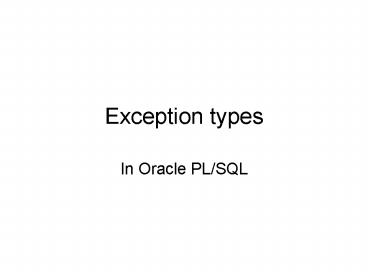Exception types PowerPoint PPT Presentation
1 / 17
Title: Exception types
1
Exception types
- In Oracle PL/SQL
2
Types of exceptions
- Named system exceptions
- Raised as a result of an error in PL/SQL or RDBMS
processing. - Named programmer-defined exceptions
- Raised as a result of errors expected in the
application code. - Unnamed system exceptions
- Raised as a result of an error in PL/SQL or RDBMS
processing, with codes, but no names. - Unnamed programmer-defined exceptions.
- These are raised in the server by the programmer.
3
Named system exceptions
- Oracle can handle
- CURSOR_ALREADY_OPENED (sqlcode -6511)
- DUP_VAL_ON_INDEX (sqlcode -1)
- INVALID_CURSOR (sqlcode -1001)
- INVALID_NUMBER (sqlcode -1722)
- LOGIN_DENIED (sqlcode -1017)
- NO_DATA_FOUND (sqlcode 100)
- TOO_MANY_ROWS (sqlcode -1422)
- etc
- These are named in the standard package in
pl/sql.
4
To handle these exceptions explicitly
- These exception names do not need to be declared.
- To handle them explicitly, put a clause in the
exception section - EXCEPTION
- When DUP_VAL_ON_INDEX
- dbms_output.put_line(record already there)
- When OTHER
- dbms_output.put_line(error occurred)
- END
5
Named Programmer-Defined Exceptions
- Application-specific exceptions
- E.g.
- Negative balance in account
- Team cannot play against itself
- Cannot stock a negative number of items
- Programmer can trap these errors and handle them.
- To do this
- Name the error
- Check for the error and raise it
- Handle the error in the EXCEPTION section
6
Example
- PROCEDURE calc_annual_sales
- (company_id_in IN company.company_idTYPE)
- IS
- no_sales_for_company EXCEPTION
- BEGIN
- -- Code here to check the number of sales
- -- a company has made. If none
- raise no_sales_for_company
- -- any other code
- EXCEPTION
- WHEN no_sales_for_company THEN
- dbms_output.put_line(company_id has made
no sales) - WHEN other THEN
- rollback work
- END
7
- create or replace procedure add_corderline
- (onum in builder.corderline.cordernotype,
- scode in builder.corderline.stock_codetype,
- qtyreq in builder.corderline.quantityrequiredty
pe) as - invalid_quantity exception
- begin
- if (qtyreq lt 0) then
- raise invalid_quantity
- end if
- insert into corderline values(qtyreq, onum,
scode) - exception
- when dup_val_on_index then
- dbms_output.put_line('primary key violation')
- dbms_output.put_line(sqlcode'--' sqlerrm)
- when invalid_quantity then
- dbms_output.put_line('quantity is invalid')
8
Unnamed system exceptions
- These errors are not pre-named, but have a
number. - They will be raised automatically by the RDBMS.
- The EXCEPTION section handles them in the WHEN
OTHER clause. - To name an unnamed error in your application
- Give the error a name using a PRAGMA, or compiler
directive, called EXCEPTION_INIT. - PL/SQL or RDBMS raise the error automatically.
- Handle the error in a specially written WHEN
clause in the exception section.
9
Unnamed system exceptions
- Weve all seen errors that Oracle throws at us
- ERROR ORA12170 TNS Connect timeout occurred
- TNS Listener does not currently know of service
requested in connect descriptor - Note
- All of these errors have an error number
- e.g. ORA 12170 means that the connection
timeout occurred. - These errors are RAISED automatically by the
system, because they are system errors.
10
Example
- DECLARE deadlock_detected EXCEPTION
- PRAGMA EXCEPTION_INIT(deadlock_detected, -60)
- BEGIN
- ...
- -- Some operation that causes an ORA-00060
- -- error (see locking)
- EXCEPTION
- WHEN deadlock_detected THEN
- -- handle the error
- END
11
Unnamed Programmer-Defined Exceptions
- This is where the server (i.e. PL/SQL code) has
declared and raised an application error and
wants the client to be able to recognise it. - When the server encounters an error, it returns
the error code to the client. - The client must declare the exception name and
check for it after control has returned from the
server.
12
Pragma EXCEPTION_INIT
- To handle error conditions that have no
predefined name, you must use - the OTHERS handler
- or
- the pragma EXCEPTION_INIT.
- A pragma
- is a compiler directive that is processed at
compile time, not at run time. - In PL/SQL, the pragma EXCEPTION_INIT tells the
compiler to associate an exception name with an
Oracle error number. - That lets you refer to any internal exception by
name and to write a specific handler for it. - When you see an error stack, or sequence of error
messages, the one on top is the one that you can
trap and handle.
13
Pragma exception_init
- Coding
- You code the pragma EXCEPTION_INIT in the
declarative part of a PL/SQL block, subprogram,
or package using the syntax - PRAGMA EXCEPTION_INIT(exception_name,
-Oracle_error_number) - where exception_name is the name of a previously
declared exception - and the number is a negative value corresponding
to an ORA- error number. - The pragma must appear somewhere after the
exception declaration in the same declarative
section.
14
Example
- DECLARE deadlock_detected EXCEPTION
- PRAGMA EXCEPTION_INIT(deadlock_detected, -60)
- BEGIN
- ...
- -- Some operation that causes an ORA-00060
error (see locking) - EXCEPTION
- WHEN deadlock_detected THEN
- -- handle the error
- WHEN OTHER
- -- handle errors
- END
15
Defining Your Own Error Messages
- Procedure RAISE_APPLICATION_ERROR
- lets you issue user-defined ORA- error messages
from stored subprograms. - That way, you can report errors to your calling
application and avoid returning unhandled
exceptions.
16
Raise_application_error
- To call RAISE_APPLICATION_ERROR
- raise_application_error(error_number, message,
TRUE FALSE) - where error_number is a negative integer in the
range -20000 .. -20999 and message is a character
string up to 2048 bytes long. - If the optional third parameter is TRUE,
- the error is placed on the stack of previous
errors. - If the parameter is FALSE (the default),
- the error replaces all previous errors.
17
How to handle errors
Declare to server Tell compiler (pragma exception init) Raise Handle
Named System Errors x x x v
Named Application Errors v x v v
Unnamed System errors v v x v
Unnamed Application Errors v v v v

